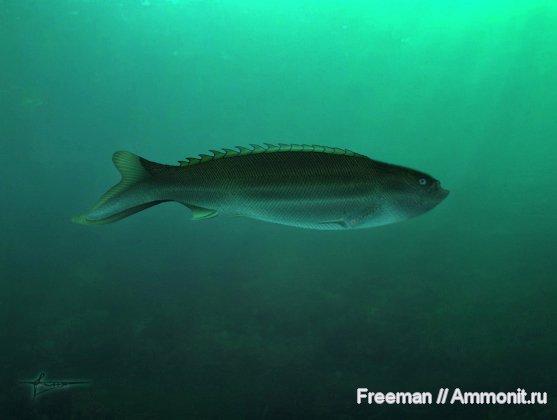
The Anaspid Pterygolepis, a typical representative of the anaspid clade. This little animal was only about 10 or 11 cm in length. Life reconstruction © Mikhail Tikhonov, original url
| Anaspida | ||
| The Vertebrates | Overview |
| Vertebrates Home | Vertebrate | Vertebrate | Bones |
|
Abbreviated Dendrogram
Chordata
│
└─Craniata
├─Myxinoidea
└─Vertebrata
├─Jamoytiiformes
└─┬─Hyperoartia (= Petromyzontiformes)
└─┬─Conodonta
└─┬─Anaspida
│ ├─Pharyngolepis
│ └─┬─Pterygolepis
│ └─Rhyncholepidida
└─┬─Pteraspidomorphi
├─Thelodonti
└─┬─Cephalaspidomorphi
└─Gnathostomata
|
Contents
|
 The Anaspid Pterygolepis, a typical representative of the anaspid clade. This little animal was only about 10 or 11 cm in length. Life reconstruction © Mikhail Tikhonov, original url |
The Paleozoic (Silurian and Devonian) anaspids (yes, the name is confusing) were a group of early jawless fish that lacked the heavy head shields of the conventional cephalaspidomorphs. Covered in thin scales, their bodies were slender and flexible, with stabililising fins. They are known from the Late Silurian of Europe and North America, but it is almost certain that these active swimmers had a much wider distribution. During the Devonian they gave up a marine existence for life in rivers and lakes. Previously the group was something of a wastebasket taxon for any unarmoured Palaeozoic agnath, but a new study of the early Silurian Jamoytius (Sansom et al 2010), shows that it and a related form, Euphanerops were actually much more primitive. Given our present synoptic coverage, the remaining anaspids can be reviewed in a single page, although it is hoped in the future that this can be expanded. And while as it stands this is hardly enough material for a Palaeos unit, it is hard to slot these specialised creatures into another category. The anaspida remain for now an intriguing but short-lived experiemnt in the early vertebrate evolutionary tree. MAK111027